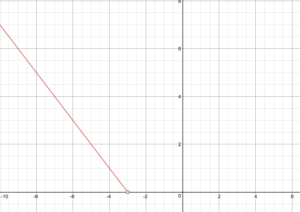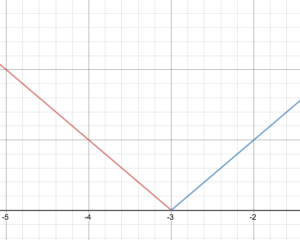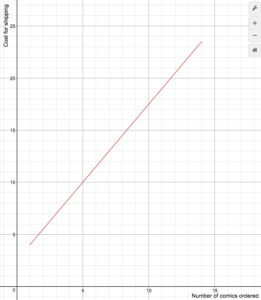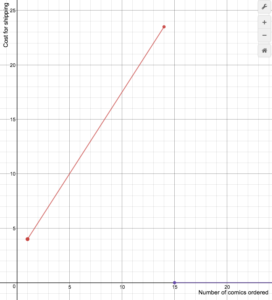Read: Graph Piecewise Functions
−x−3[/latex], erasing the part where x is greater than [latex]-3[/latex]. Place an open circle at [latex](-3,0)[/latex]. Now place the line [latex]f(x) = x+3[/latex] on the graph, starting at the point [latex](-3,0)[/latex]. Note that for this portion of the graph, the point [latex](-3,0)[/latex] is included, so you can remove the open circle.
Now place the line [latex]f(x) = x+3[/latex] on the graph, starting at the point [latex](-3,0)[/latex]. Note that for this portion of the graph, the point [latex](-3,0)[/latex] is included, so you can remove the open circle.
 The two graphs meet at the point [latex](-3,0)[/latex]
The domain of this function is all real numbers because [latex](-3,0)[/latex] is not included as the endpoint of [latex]f(x) = −x−3[/latex], but it is included as the endpoint for [latex]f(x) = x+3[/latex].
The range of this function starts at [latex]f(x)=0[/latex] and includes [latex]0[/latex], and goes to infinity, so we would write this as [latex]x\ge0[/latex][/hidden-answer]
In the next example, we will graph a piecewise defined function that models the cost of shipping for an online comic book retailer.
The two graphs meet at the point [latex](-3,0)[/latex]
The domain of this function is all real numbers because [latex](-3,0)[/latex] is not included as the endpoint of [latex]f(x) = −x−3[/latex], but it is included as the endpoint for [latex]f(x) = x+3[/latex].
The range of this function starts at [latex]f(x)=0[/latex] and includes [latex]0[/latex], and goes to infinity, so we would write this as [latex]x\ge0[/latex][/hidden-answer]
In the next example, we will graph a piecewise defined function that models the cost of shipping for an online comic book retailer.
Example
An on-line comic book retailer charges shipping costs according to the following formula [latex]S(n)=\begin{cases}1.5n+2.5\text{ if }1\le{n}\le14\\0\text{ if }n\ge15\end{cases}[/latex] Draw a graph of the cost function.Answer: First, draw the line [latex]S(n)=1.5n+2.5[/latex]. We can use transformations: this is a vertical stretch of the identity by a factor of [latex]1.5[/latex], and a vertical shift by [latex]2.5[/latex].
 S(n)=1.5n+2.5
S(n)=1.5n+2.5 S(n) = 1.5n+2.5 for 1=n=14
S(n) = 1.5n+2.5 for 1=n=14
Summary
To graph piecewise functions, first identify where the domain is divided. Graph functions on the domain using tools such as plotting points, or transformations. Be careful to use open or closed circles on the endpoints of each domain based on whether the endpoint is included.Licenses & Attributions
CC licensed content, Original
- Revision and Adaptation. Provided by: Lumen Learning License: CC BY: Attribution.
CC licensed content, Shared previously
- College Algebra, Unit 1.4 Function Notation. Authored by: Carl Stitz and Jeff Zeager. Located at: https://www.stitz-zeager.com/szca07042013.pdf. License: CC BY: Attribution.
- Ex 2: Graph a Piecewise Defined Function. Authored by: James Sousa (Mathispower4u.com) . License: CC BY: Attribution.
CC licensed content, Specific attribution
- College Algebra. Provided by: OpenStax Authored by: Jay Abramson, et al.. Located at: https://openstax.org/books/precalculus/pages/1-introduction-to-functions. License: CC BY: Attribution. License terms: Download for free at: http://cnx.org/contents/[email protected].
